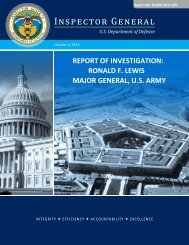Command Red Team
2gWzzvB
2gWzzvB
Create successful ePaper yourself
Turn your PDF publications into a flip-book with our unique Google optimized e-Paper software.
Executive Summary<br />
investment in a specific point of view will have<br />
trouble reassessing their assumptions and<br />
adopting new paradigms. Accordingly, the red<br />
team should strive to use its outside vantage point<br />
to see issues that might escape others. In<br />
addition, the red team can focus on helping<br />
individuals consider the possibility that their<br />
expertise on a problem set might cause them to<br />
discount or misinterpret new information. Some<br />
individual factors include logical fallacies,<br />
confirmation bias, status quo bias, fighting the<br />
plan, paradox of experience, mirror imaging,<br />
ethnocentrism, policy bias, information overload,<br />
oversimplification and tunnel vision, hidden<br />
assumptions, assuming away the problem,<br />
overconfidence or over-pessimism, failure to<br />
make the call, and elegance vice insight.<br />
Organizational Factors<br />
Multinational Considerations<br />
Cohesive teams may unconsciously stifle dissent<br />
and subtly discourage alternative thinking.<br />
Helping counter the effects of these institutional<br />
influences, while simultaneously presenting<br />
alternative perspectives, requires a cautious,<br />
balanced approach by the red team. Common<br />
forms of institutional bias and influence include<br />
group think, tribal think, no think, boss think,<br />
silent think, false consensus, death by<br />
coordination, institutional inertia, hubris, and<br />
conflict of interest.<br />
Some of the organizations that employ red teams<br />
may have multinational components, either as an<br />
integrated or parallel command structure, or in the<br />
form of national liaison officers. Such red team<br />
interactions with foreign officers have many<br />
advantages, but like all interactions with foreign<br />
officers, they can also pose unique cultural issues<br />
and potential security challenges.<br />
<strong>Red</strong> <strong>Team</strong> Activities<br />
<strong>Red</strong> teams are general purpose<br />
decision support assets that can<br />
enhance problem-solving efforts<br />
in all functional areas, in all<br />
organizations, and at all<br />
echelons.<br />
<strong>Red</strong> teams employ a variety of tools to frame<br />
problems, challenge assumptions, analyze<br />
conditions, explore solutions, and support<br />
decision making. While red teams can support<br />
decision making in all functional areas, they can<br />
be especially useful in those areas where complex<br />
vii



